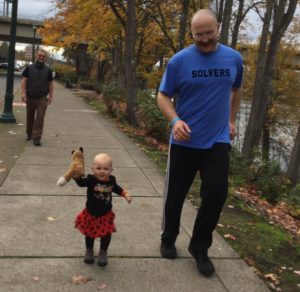Let’s Be Solvers!
Before our daughter’s wedding, she asked a friend and one of her brothers if they would coordinate things that day – serve as problem solvers and facilitators for many possible questions that could come up. Her friend had special t-shirts made for them so they’d be easy to spot. One was printed “PROBLEM”; the other, “SOLVERS.” They made a great team!While thinking about a title for the section of my website designated for “helpful ideas” for individual, family, group, and national problem-solving, my son’s t-shirt stuck in my mind. (He requested that he get to wear “SOLVERS.”) So here it is (for ages 1, in a ladybug skirt, on up to any age at all)! Enjoy checking out these ideas that really work. (And do come back for another visit, as more ideas are posted.)

Quick Tip: Bounce Back. Don’t Pounce Back
A parrot is a tool? No, but it is a reminder of the #1 top communication tool that helps us really listen to others. Parrots repeat what they hear. We don’t “parrot back” what someone has said, but we do “Bounce Back” for them. We listen and then put in our own words, sincerely, what we’ve just heard them say. That keeps us from responding defensively or in anger. It also lets us make sure we’ve heard correctly, and it lets the other person know we’re listening and want to understand their viewpoint. That changes things!
Instead of saying, “Come on! I was only ten minutes late. It couldn’t have been that big of a deal!” you can Bounce Back what they said: “So when I was late, you were worried that I might not show at all, and you were counting on me to be there to help you set up the display?” Give them a chance to say more. Keep listening and Bouncing Back until you know they feel understood. I keep a paper parrot on my kitchen wall to help me remember to Bounce Back instead of Pounce Back.
What’s up with Family Meetings?
How about trying something this year that has amazing potential for making family life more fun, and at the very same time lets the entire family learn great problem-solving skills to use anywhere? We have been using family meetings for years – on a whole gob of problems, and other things to be decided – and we know family meetings work! Give it a try; then email me. I’d love to hear of your good work! And remember, if you are a family of two or housemates, “family” meetings (house meetings) can work just as well as for more than two. Starting family meetings now means whoever takes part is learning great skills this year, and using a cool way to make decisions, together.
Family Meetings – Why?
- Conflict is a part of family life. Even if unnecessary conflict is minimized, there will still be many instances of conflict needing worked through
- People (children and adults) learn by doing, and learning how to resolve conflicts is one of life’s most useful skills. Problem-solving in family meetings uses skills in listening, describing, Bounce Back [paraphrasing], brainstorming, evaluating ideas, cooperation, empathy, consensus building. Training for life happens as problems are solved in the family meeting.
- Designating a time and place for problem-solving allows for cool-down, hopefulness, using procedures that are known to work, and puts everyone at their best, rather than reacting in the moment of stress.
- Group decision by consensus can bring creative, effective ideas that no one thought of previously.
- Consensus decision making is known to have a good compliance rate.
- Children learn to see themselves as capable problem-solvers worthy of respect.
- Adults don’t have to be the experts on what will work; adults can tap into kid-help with concerns they bring to the family; they build a relationship of trust, respect, and cooperation with their children.
- Refreshments taste good.

Family Meetings – How?
- Keep an agenda posted for the upcoming meeting (see sample Agenda form below).
- Decide on frequency of meetings, time, and place.
- Volunteers sign up to facilitate, record, and to be in charge of refreshments (the latter being a key to successful meetings!). Don’t underestimate children’s abilities to facilitate, but don’t push them into this role before they feel comfortable and ready to do so. Let them learn by parents’ modeling for some time, and then start them with one item at one meeting, rather than an entire meeting. Make that one of the less complicated issues.
- Limit the number of agenda items to what can logically be covered in a reasonable time, so as not to wear people out.
Conducting the meeting:
- Facilitator asks for good-news announcements and compliments. Please don’t skip this step. Its purpose is much broader than just sharing information.
- Facilitator reminds everyone about the ground rules to talk one at a time and be respectful (or other ground rules all have agreed upon).
- Facilitator then reads the 1st agenda item and asks for the person who posted it to describe his/her concern.
- Facilitator asks another person to “Bounce Back” the concern of the speaker (put in your own words what you just heard that person say). If necessary, the facilitator can do this him-/herself, but it keeps more people actively involved if the bouncing back is passed around.
- Facilitator asks others who wish to speak or ask clarifying questions to do so, keeping balance and including all who wish to speak. (Bounce Back at times.)
- When all who wish to speak have done so, the facilitator asks for ideas to solve the concern, and reminds all that we will not evaluate or criticize any ideas yet.
- When all serious ideas have been given, evaluation begins. Facilitator asks questions such as: Which ideas seem workable? How can this idea be made better for everyone? If we were in _______’s shoes what might we want to have happen? What would happen if we tried ____________?
- When agreement is reached, the Recorder writes down the details.
- If agreement is not reached, the Facilitator summarizes the discussion, and the Recorder writes down highlights. (The concern is handled in the way it would have been without the family meeting or is delayed until a later time.)
- The next item on the agenda is discussed using the same process.
- The meeting closes with the Recorder reading out what was agreed upon at the meeting, followed by the Facilitator thanking all for their participation.
- Refreshments are served.
Sample Agenda Form:Family Meeting Agenda
Date_____________ Time___________
First:**Announcements/Compliments**
Then: Things to Talk About:
1.
2.
3.
Facilitator ______________________
Recorder _______________________
Refreshments ___________________